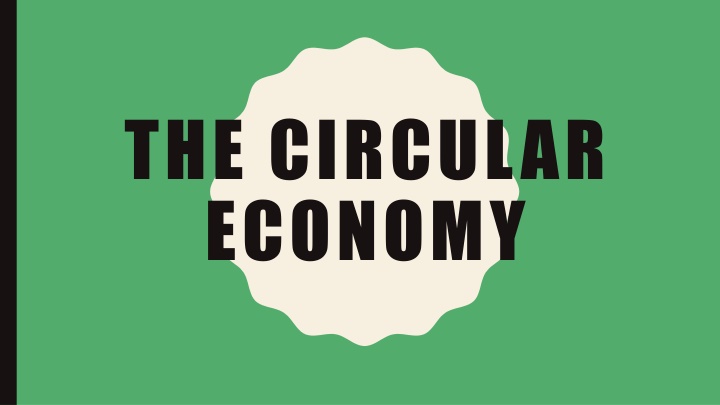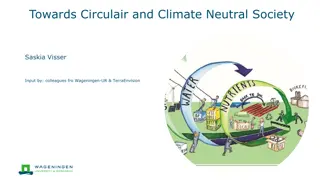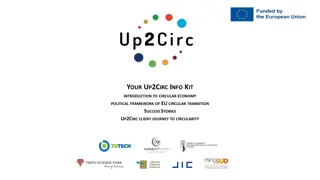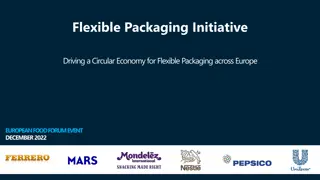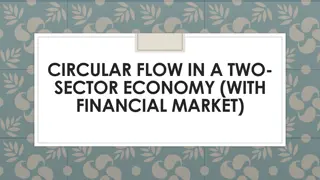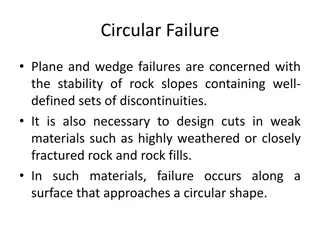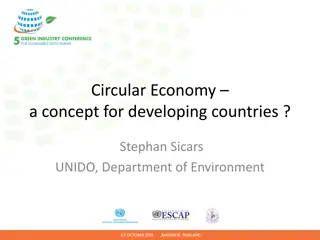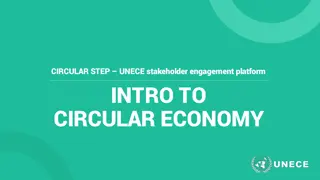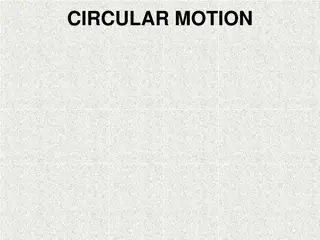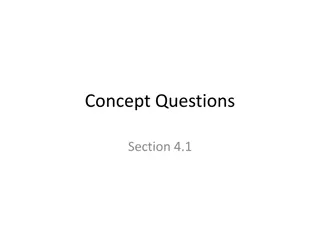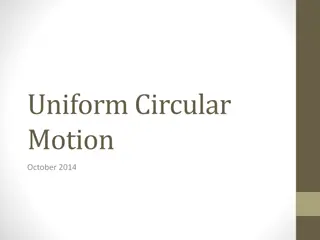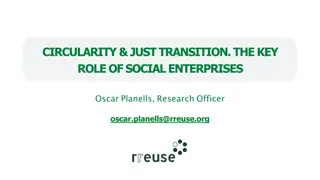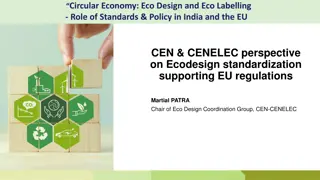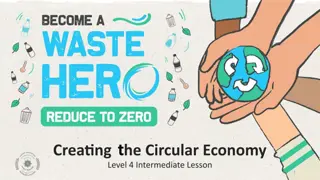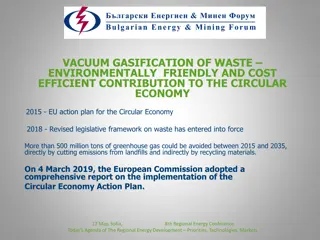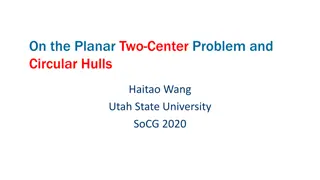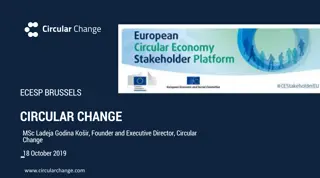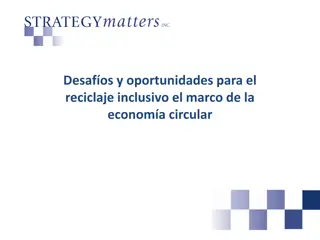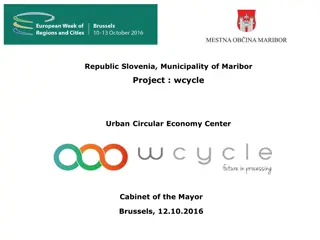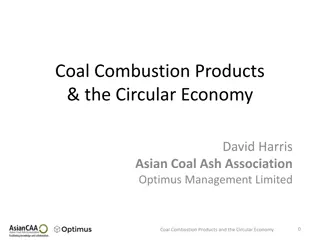THE CIRCULAR ECONOMY
Our current linear economy leads to waste, pollution, and climate change. Shifting towards a circular economy model involves reusing, recycling, and redesigning products to tackle global challenges like biodiversity loss and waste management.
Uploaded on Mar 13, 2025 | 0 Views
Download Presentation

Please find below an Image/Link to download the presentation.
The content on the website is provided AS IS for your information and personal use only. It may not be sold, licensed, or shared on other websites without obtaining consent from the author.If you encounter any issues during the download, it is possible that the publisher has removed the file from their server.
You are allowed to download the files provided on this website for personal or commercial use, subject to the condition that they are used lawfully. All files are the property of their respective owners.
The content on the website is provided AS IS for your information and personal use only. It may not be sold, licensed, or shared on other websites without obtaining consent from the author.
E N D
Presentation Transcript
THE CIRCULAR ECONOMY
CONTENTS Linear and Circular Economy Principles and aims of the circular economic model Transition towards a circular economy Conclusions
THE LINEAR ECONOMY In our current economy, we take materials from the Earth, make products from them, and eventually throw them away as waste the process is linear. This design however has contributed towards climate change, biodiversity loss, waste, and pollution. There is a pressing need to rethink our economic model and construct a viable circular and sustainable way of production and economic growth. We need to rethink how we manage resources,how we make and use products,and what we do with the materials afterwards.
DEFINING THE CIRCULAR ECONOMY A circular economy is a model of production and consumption, which involves sharing, leasing, reusing, repairing, refurbishing and recycling existing materials and products for as long as possible.In this way,the life cycle of products is extended.
AIMS AND PRINCIPLES OF THE CIRCULAR ECONOMY CE aims to tackle global challenges such as climate change, biodiversity loss, waste, and pollution by emphasizing the design-based implementation of the three base principles of the model. The three principles required for the transformation to a circular economy are: designing out waste and pollution, keeping products and materials in use, and regenerating natural systems.
POLLUTION AND WASTE A major impact of the linear economy is the massive generation of waste.The model is designed to produce and consume as much as possible, leading to a constant flow of waste and pollution. This waste ends up in landfills, oceans, and other natural habitats, where it poses a significant threat to wildlife and ecosystems. Landfills are overflowing with waste that may take hundreds of years to decompose,polluting the soil,water,and air. Some predict that there will be more plastic than fish in the ocean by 2050. A redesign of our economic model towards reusing, recycling and sharing goods is crucial in reversing the alarming trends. For example, fast fashion, with clothing being produced quickly and cheaply renders clothes short-term and disposable, thus depleting natural resources and generating massive amounts of textile waste. In contrast, a circular fashion model would focus on the use of sustainable materials,clothing rental,and the repair and recycling of clothing.
CLIMATE CHANGE Climate change is the result of extensive energy production and high carbon emissions. A reduction in total annual greenhouse gas emissions is thus necessary. According to the European Environment Agency, industrial processes and product use are responsible for 9.1% of greenhouse gas emissions in the EU. It has been estimated that by 2050, 9 billion tones of CO2 can be reduced by implementing circular economy strategies in five sectors: cement, aluminum, steel, plastics, and food (European Investment Bank,2023).
BIODIVERSITY, NATURAL RESOURCES AND WASTE Biodiversity is threatened by greenhouse emissions, climate change and the intensive use of natural resources. Unique and beautiful landscapes are destroyed by the efforts of industries and states to exploit all available natural resources to produce goods. Similarly, various ecosystems and species habitats are disrupted by extensive industrial activity. Biodiversity can be protected by rethinking the design of products. Products must be redesigned so that they can be reused,upgraded and repaired.Biodiversity is also threatened by excessive waste. As massive production of goods increases so does the waste. Packaging is a growing issue and, on average,the average European generates nearly 180 kilos of packaging waste per year. Products must be redesigned to address this negative externality. Products that can be reused, upgraded and repaired last longer and can reduce waste, while this redesign must include packaging itself.
TRANSITIONING TO A CIRCULAR ECONOMY: THE EU During the last decade,the EU has put forth many proposals,plans and directives related to the transition to a circular economy. These include directives on eco-design (the redesign of products to last longer, use environmentally friendly resources and become more durable and reusable) and waste management. In 2020, the European Union released its Circular Economy Action Plan. This plan includes measures and laws to optimize the use of raw materials, products and waste. For example, the plan intends to enable the development of a new market for secondary raw materials. The EU has focused more on sectors that use most resources and where the potential for circularity is high such as: electronics,batteries and vehicles,packaging,plastics,textiles,construction and buildings. EU states are following EU directives and some have set ambitious goals. The Netherlands, Belgium, France and Germany are leading the way in this transition. For example, Netherlands has declared that it aims to reuse 50% of all materials by 2030 and to convert waste into reusable materials anywhere it is possible. The next goal is then to make the country shift towards a 100% waste-free economy by 2050.
INCENTIVES FOR CIRCULARITY The EU has suggested, and EU states have introduced economic incentives for companies to embrace a circular model. The most common incentives are: Financial incentives for companies that redesign products. Pricing negative externalities, thus making it costly for companies to cause pollution and loss of biodiversity. Tax deductions for repairing goods.Consumers are encouraged to repair appliances by reducing tax on repair services. Raising public awareness on the urgent need to change the way we produce and discard goods.
CONCLUSIONS States, regional and international organisations are realizing the need to redesign our production model and are taking action,with initiatives,new policies and laws. However, there is a pressing need to move faster. For example we expect the use of plastics to double in the following decades and despite our efforts the global economy today is 8.6% circular while just two years ago it was 9.1%.As overall production grows,the transition must catch up in order to achieve sustainable development.
